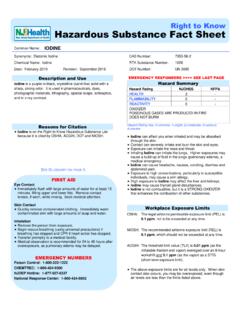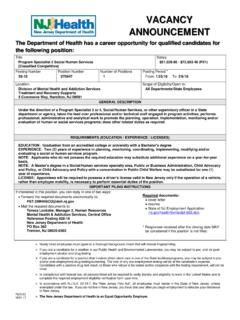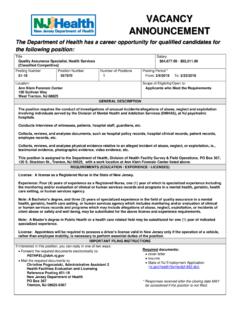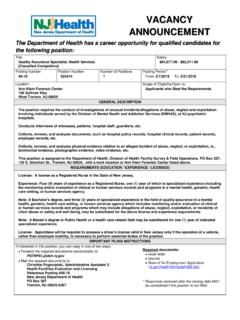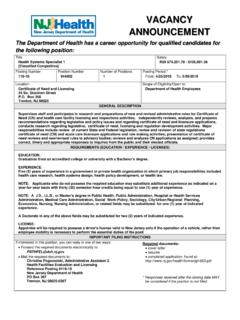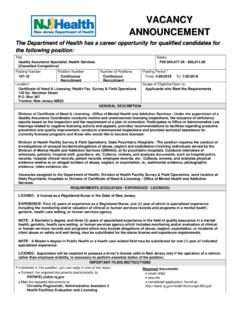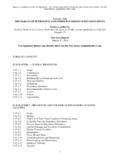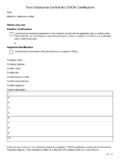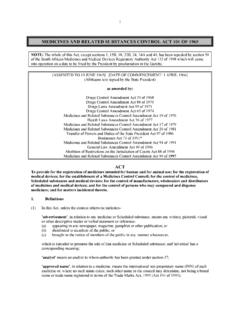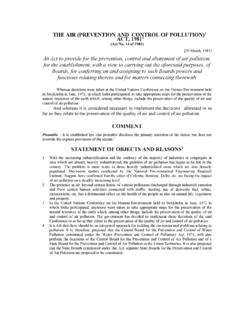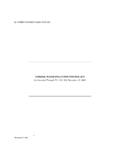Transcription of Right to Know Hazardous Substance Fact Sheet
1 Right to know Hazardous Substance fact Sheet Common Name: SILVER NITRATE Synonyms: Argerol; Lunar Caustic Chemical Name: Nitric Acid Silver (1+) Salt Date: May 2000 Revision: May 2009 CAS Number: 7761-88-8 RTK Substance Number: 1672 DOT Number: UN 1493 Description and Use Silver Nitrate is an odorless, colorless or white, crystalline (sand-like) solid. It is used in photography, medicines, hair dyes, making mirrors and silver plating, and as a chemical intermediate. Reasons for Citation f Silver Nitrate is on the Right to know Hazardous Substance List because it is cited by OSHA, ACGIH, DOT, NIOSH, DEP and EPA. f This chemical is on the Special Health Hazard Substance List.
2 SEE GLOSSARY ON PAGE 5. FIRST AID Eye Contact f Immediately flush with large amounts of water for at least 30 minutes, lifting upper and lower lids. Remove contact lenses, if worn, while flushing. Seek medical attention immediately. Skin Contact f Quickly remove contaminated clothing. Immediately wash contaminated skin with large amounts of water. Seek medical attention immediately. Inhalation f Remove the person from exposure. f Begin rescue breathing (using universal precautions) if breathing has stopped and CPR if heart action has stopped. f Transfer promptly to a medical facility. EMERGENCY NUMBERS Poison Control: 1-800-222-1222 CHEMTREC: 1-800-424-9300 NJDEP Hotline: 1-877-927-6337 National Response Center: 1-800-424-8802 EMERGENCY RESPONDERS >>>> SEE LAST PAGE Hazard Summary Hazard Rating NJDOH NFPA HEALTH 3 - FLAMMABILITY 0 - REACTIVITY 0 - CORROSIVE AND STRONG OXIDIZER POISONOUS GASES ARE PRODUCED IN FIRE CONTAINERS MAY EXPLODE IN FIRE Hazard Rating Key: 0=minimal; 1=slight; 2=moderate; 3=serious.
3 4=severe f Silver Nitrate can affect you when inhaled and by passing through the skin. f Silver Nitrate is CORROSIVE and contact can severely irritate and burn the skin and eyes with possible eye damage. f Inhaling Silver Nitrate can irritate the nose, throat and lungs. f Exposure to Silver Nitrate can cause headache, dizziness, nausea and vomiting. f High levels of this Substance may reduce the blood s ability to transport Oxygen, causing headache, fatigue, dizziness, and a blue color to the skin and lips (methemoglobinemia). f Repeated exposures to Silver Nitrate can cause blue-gray discoloration (argyria) of the eyes, skin, inner nose, mouth, throat and internal body organs.
4 This may take years to develop but is permanent. f Silver Nitrate may affect the kidneys. f Silver Nitrate is not combustible, but it is a STRONG OXIDIZER that enhances the combustion of other substances. Workplace Exposure Limits The following exposure limits are for soluble Silver compounds (measured as Silver): OSHA: The legal airborne permissible exposure limit (PEL) is mg/m3 averaged over an 8-hour workshift. NIOSH: The recommended airborne exposure limit (REL) is mg/m3 averaged over a 10-hour workshift. ACGIH: The threshold limit value (TLV) is mg/m3 averaged over an 8-hour workshift. f The above exposure limits are for air levels only. When skin contact also occurs, you may be overexposed, even though air levels are less than the limits listed above.
5 SILVER NITRATE Page 2 of 6 Determining Your Exposure f Read the product manufacturer s Material Safety Data Sheet (MSDS) and the label to determine product ingredients and important safety and health information about the product mixture. f For each individual Hazardous ingredient, read the New Jersey Department of Health Hazardous Substance fact Sheet , available on the RTK website ( ) or in your facility s RTK Central File or Hazard Communication Standard file. f You have a Right to this information under the New Jersey Worker and Community Right to know Act, the Public Employees Occupational Safety and Health (PEOSH) Act if you are a public worker in New Jersey, and under the federal Occupational Safety and Health Act (OSHA) if you are a private worker.
6 F The New Jersey Right to know Act requires most employers to label chemicals in the workplace and requires public employers to provide their employees with information concerning chemical hazards and controls. The federal OSHA Hazard Communication Standard (29 CFR ) and the PEOSH Hazard Communication Standard ( 12:100-7) require employers to provide similar information and training to their employees. This fact Sheet is a summary of available information regarding the health hazards that may result from exposure. Duration of exposure, concentration of the Substance and other factors will affect your susceptibility to any of the potential effects described below. Health Hazard Information Acute Health Effects The following acute (short-term) health effects may occur immediately or shortly after exposure to Silver Nitrate: f Contact can severely irritate and burn the skin with rash and blisters.
7 F Silver Nitrate can irritate and burn the eyes with possible eye damage. f Inhaling Silver Nitrate can irritate the nose, throat and lungs causing coughing, wheezing and/or shortness of breath. f Exposure to Silver Nitrate can cause headache, dizziness, nausea and vomiting. f High levels of this Substance may reduce the blood s ability to transport Oxygen, causing headache, fatigue, dizziness, and a blue color to the skin and lips (methemoglobinemia). Exposure to very high levels can cause trouble breathing, collapse and even death. Chronic Health Effects The following chronic (long-term) health effects can occur at some time after exposure to Silver Nitrate and can last for months or years: Cancer Hazard f According to the information presently available to the New Jersey Department of Health, Silver Nitrate has not been tested for its ability to cause cancer in animals.
8 Reproductive Hazard f While Silver Nitrate has been tested, further testing is required to assess its potential to cause reproductive harm. Other Effects f Silver Nitrate can irritate the lungs. Repeated exposure may cause bronchitis to develop with coughing, phlegm, and/or shortness of breath. f Repeated exposures to Silver Nitrate can cause blue-gray discoloration (argyria) of the eyes, skin, inner nose, mouth, throat and internal body organs. This may take years to develop but is permanent. f Silver Nitrate may affect the kidneys. Medical Medical Testing For frequent or potentially high exposure (half the PEL or greater), the following are recommended before beginning work and at regular times after that: f Kidney function tests If symptoms develop or overexposure is suspected, the following are recommended: f Lung function tests f Examine the eyes, inner nose, throat and skin periodically to detect early changes in body color.
9 Any evaluation should include a careful history of past and present symptoms with an exam. Medical tests that look for damage already done are not a substitute for controlling exposure. Request copies of your medical testing. You have a legal Right to this information under the OSHA Access to Employee Exposure and Medical Records Standard (29 CFR ). Mixed Exposures f Smoking can cause heart disease, lung cancer, emphysema, and other respiratory problems. It may worsen respiratory conditions caused by chemical exposure. Even if you have smoked for a long time, stopping now will reduce your risk of developing health problems. SILVER NITRATE Page 3 of 6 Workplace Controls and Practices Very toxic chemicals, or those that are reproductive hazards or sensitizers, require expert advice on control measures if a less toxic chemical cannot be substituted.
10 Control measures include: (1) enclosing chemical processes for severely irritating and corrosive chemicals, (2) using local exhaust ventilation for chemicals that may be harmful with a single exposure, and (3) using general ventilation to control exposures to skin and eye irritants. For further information on workplace controls, consult the NIOSH document on Control Banding at The following work practices are also recommended: f Label process containers. f Provide employees with hazard information and training. f Monitor airborne chemical concentrations. f Use engineering controls if concentrations exceed recommended exposure levels. f Provide eye wash fountains and emergency showers.


